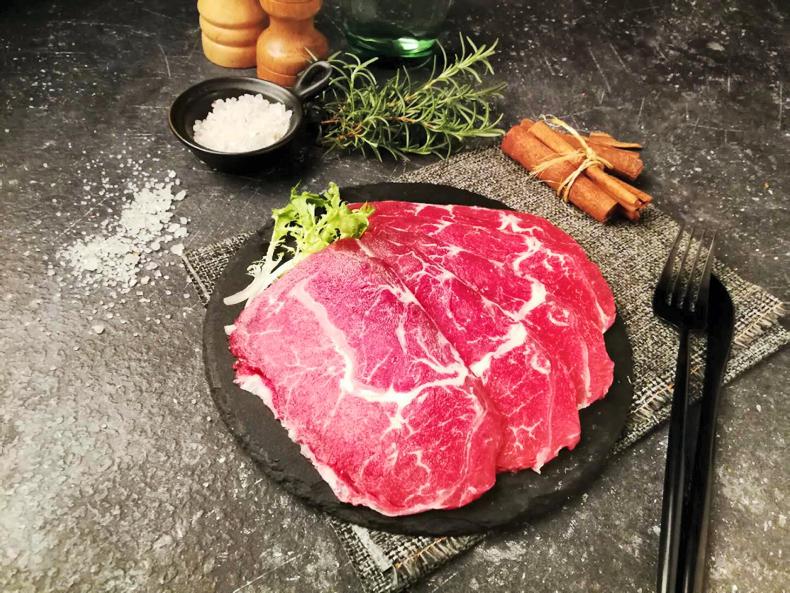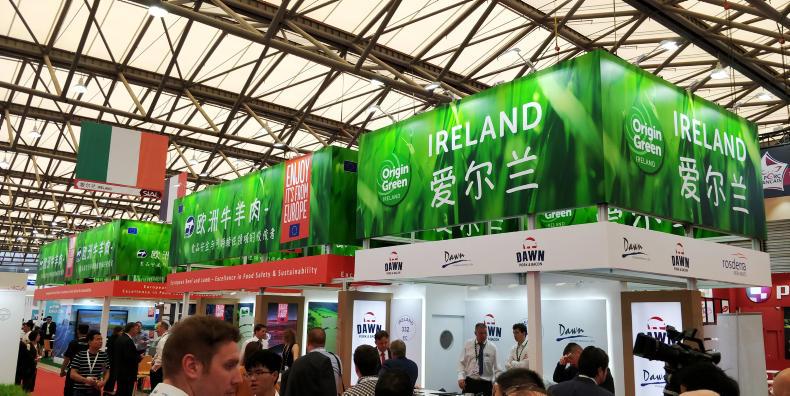The first half of 2019 saw Chinese demand for beef imports increase 61% on the same period last year which was then a record level.
In 2018, total Chinese beef imports were just over 1m tonnes, a threefold increase since 2014.
With the huge growth in the first half of this year, it is clear that 2019 will be another record year for Chinese beef imports.
Irish beef in China
The good news for Ireland is that Irish beef has become well established in the first half of this year and with just seven factories currently approved, they exported just under 3,000t of beef cuts to China.
Based on this performance, if the further 12 factories that have applied for approval get authorised in the coming weeks, then it is clear that China will be a significant export market for Irish beef by the end of 2019.

A sample of Irish beef in China.
This would be a positive development in what has been an extremely negative year for Irish beef producers.
Argentina’s exports continue to grow
The other major development this year so far is that Argentina has nudged ahead of Brazil as the top supplier of imported beef, accounting for 22.2% of Chinese beef imports, with Brazil supplying 21.9% of imports.
Uruguay comes next, supplying 20.8% of Chinese beef imports, with the other big suppliers being Australia on 17% and New Zealand with a 14.2% share of imports.
Other countries that exported small quantities of beef to China include Canada, the USA, Costa Rica and Chile.
South Africa was approved to join this list recently.
The UK expects to be approved by the end of this year and while there is plenty of competition, it is clear that year-on-year demand growth is more than accommodating the supply available.
Prices
The Chinese beef market is small for high-value steak cuts, but is strong for what would be considered the lower-value cuts in Ireland or across the EU.
Current price for shin is CNY65.51/kg (€8.22/kg equivalent), flank is CNY59.64/kg (€7.55/kg) and beef blocks CNY60.71/kg (€7.68/kg).
Importance of Asia
Asia is the new frontier for beef markets, as western markets, in what is considered the developed world, are either stagnant or in decline.
The rapidly developing Asian economies, particularly China, Japan and South Korea, are all showing consistent year-on-year growth and are absorbing the increased supply from South America.
There, Brazil continues to grow its production and exports, but the big story is the performance of Argentina.
In 2014, their beef exports had fallen to 140,000t from over 700,000t in 2005 when they were the biggest beef exporter in the world.
A socialist government came to power in 2005 and imposed an import tax on beef to control prices in the home markets.
This decimated exports and it was the arrival of a free-market government in 2015 that has led to Argentina recovering much of its export capacity.
However, elections are taking place in Argentina this autumn and a return to a socialist government is a real possibility, which, if it happens, is likely to have a serious impact on the Argentinean beef export business.
The first half of 2019 saw Chinese demand for beef imports increase 61% on the same period last year which was then a record level.
In 2018, total Chinese beef imports were just over 1m tonnes, a threefold increase since 2014.
With the huge growth in the first half of this year, it is clear that 2019 will be another record year for Chinese beef imports.
Irish beef in China
The good news for Ireland is that Irish beef has become well established in the first half of this year and with just seven factories currently approved, they exported just under 3,000t of beef cuts to China.
Based on this performance, if the further 12 factories that have applied for approval get authorised in the coming weeks, then it is clear that China will be a significant export market for Irish beef by the end of 2019.

A sample of Irish beef in China.
This would be a positive development in what has been an extremely negative year for Irish beef producers.
Argentina’s exports continue to grow
The other major development this year so far is that Argentina has nudged ahead of Brazil as the top supplier of imported beef, accounting for 22.2% of Chinese beef imports, with Brazil supplying 21.9% of imports.
Uruguay comes next, supplying 20.8% of Chinese beef imports, with the other big suppliers being Australia on 17% and New Zealand with a 14.2% share of imports.
Other countries that exported small quantities of beef to China include Canada, the USA, Costa Rica and Chile.
South Africa was approved to join this list recently.
The UK expects to be approved by the end of this year and while there is plenty of competition, it is clear that year-on-year demand growth is more than accommodating the supply available.
Prices
The Chinese beef market is small for high-value steak cuts, but is strong for what would be considered the lower-value cuts in Ireland or across the EU.
Current price for shin is CNY65.51/kg (€8.22/kg equivalent), flank is CNY59.64/kg (€7.55/kg) and beef blocks CNY60.71/kg (€7.68/kg).
Importance of Asia
Asia is the new frontier for beef markets, as western markets, in what is considered the developed world, are either stagnant or in decline.
The rapidly developing Asian economies, particularly China, Japan and South Korea, are all showing consistent year-on-year growth and are absorbing the increased supply from South America.
There, Brazil continues to grow its production and exports, but the big story is the performance of Argentina.
In 2014, their beef exports had fallen to 140,000t from over 700,000t in 2005 when they were the biggest beef exporter in the world.
A socialist government came to power in 2005 and imposed an import tax on beef to control prices in the home markets.
This decimated exports and it was the arrival of a free-market government in 2015 that has led to Argentina recovering much of its export capacity.
However, elections are taking place in Argentina this autumn and a return to a socialist government is a real possibility, which, if it happens, is likely to have a serious impact on the Argentinean beef export business.







 This is a subscriber-only article
This is a subscriber-only article










SHARING OPTIONS: